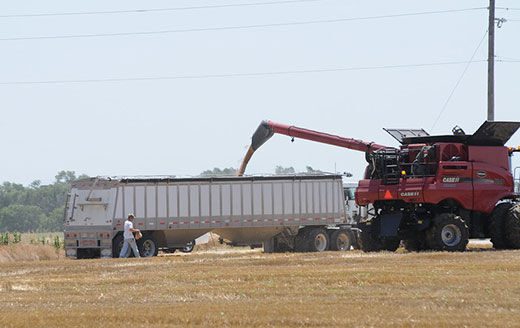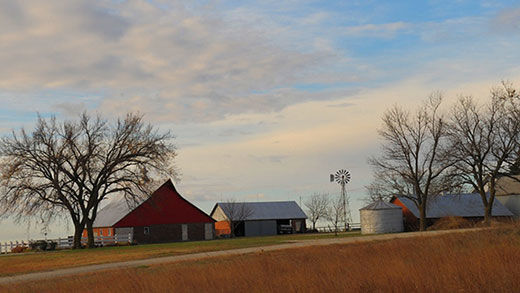Ag banks are ready to serve
Farm income and credit conditions are continuing to show signs of weakness, but at a slower pace.
These pressures could put a small percentage of farm bank customers into difficulty getting ongoing operating loans.
“In talking with other bankers, we all have a few customers who had equity to go one more year, but at the end of the year, there may be a few—or even more than a few, depending on the overall makeup of your customer base—that cannot survive another negative cash flow year,” said Brent Wiedeman, president and CEO of the Farmers & Merchants Bank of Colby, Kansas, and northwest district director of the Community Bankers Association of Kansas. “There’s only so much equity that you can tap into. When it’s gone it’s gone.”
According to the first quarter 2018 Tenth District Survey of Agricultural Credit Conditions of the Federal Reserve Bank of Kansas City, Missouri, reduced farm income contributed to intensifying cash-flow concerns and tightening lending standards. Cash-flow shortages continued to limit the availability of working capital, and financing needs continued to rise.
Despite moderate increases in prices of key agricultural commodities, district bankers reported that farm income and spending continued to decrease. The decline in the first quarter makes 2018 the fifth consecutive year bankers have reported lower farm income than the year before.
Although household spending and capital spending also have continued to decline, the pace of the decline in capital spending, which has historically followed farm income, has been relatively slower. Changes in farm income now seem to be more in line with changes in household spending, as farm households have attempted to adjust to lower incomes by reducing their expenses.
Reduced farm income also restricted cash flow and contributed to more farm loan denials than in recent years. In the first quarter, more than 8 percent of farm loan requests were denied because of customer cash-flow shortages. The largest share of those denials, the KC Fed report said, occurred in Oklahoma, where wheat production makes up a larger share of farm revenue.
Despite a recent uptick in commodity prices, cash-flow shortages have reinforced concerns about liquidity in agricultural lending. In the first quarter of 2018, crop prices rose to their highest levels since 2016. However, according to national data from the U.S. Department of Agriculture, working capital on farms across the country is expected to decline 65 percent in 2018 when compared to 2012 levels.
Restructuring debt
Alongside reduced liquidity on farms, bankers have continued to restructure debt, though at a slower pace than in previous quarters. Compared with last year, only bankers in western Missouri saw a higher percentage of loans that were restructured to meet short-term liquidity needs.
Although restructuring is still being used, it was on a lower percentage of loans than in previous quarters. The slower pace of restructuring, alongside a slower pace of decline in farm income, could suggest that higher prices played a role in stabilizing the farm economy in the first quarter.
Similar to farm income, credit conditions continued to stabilize but remained weak in the first quarter of 2018. Rates of repayment on non-real estate farm loans continued to decline but at a slightly slower pace than in previous quarters. In addition, farm loan repayment rates were expected to decline again in the second quarter of 2018, but the pace of decline was expected to remain unchanged. In contrast, growth in loan demand ticked up slightly in the first quarter and was expected to increase substantially in the second quarter of 2018, while growth in loan renewals and extensions was expected to slow.
In addition, the amount of debt carried over from the previous year also continued to increase, but at a slower rate. Bankers in every state reported that slightly fewer farm borrowers had an increase in carryover debt compared with last year. However, carryover debt continued to increase for some farm borrowers in the midst of weak conditions throughout farm country. In Kansas, the Mountain States and Nebraska, the percent of farm borrowers with an increase in carryover debt remained higher than in 2015.
Responding to need
Bankers are responding to producer needs of ongoing cash-flow concerns in various ways; by restructuring debt, increasing and maintaining collateral requirements.
The bad news is bankers are also—in some cases—denying loans.
The Fed report indicated that higher interest rates could put additional pressure on cash flows, but moderate increases in crop prices and further declines in cropland rental rates could help improve profit margins of crop producers in the District in coming months.
Sign up for HPJ Insights
Our weekly newsletter delivers the latest news straight to your inbox including breaking news, our exclusive columns and much more.
David Widmar, researcher at the Center for Commercial Agriculture at Purdue University, said in one of his latest reports that the KC Fed data shows that the annual change in the share of delinquencies was slower in 2017 than the recent years. Second, these data show that while non-real estate farm loan delinquencies are currently low, this can change rapidly. In 2009, the share jumped 1.67 percentage points.
“Such a jump in today’s farm economy would be concerning,” Widmar said.
In 2017, the share of farm real estate loans delinquent reached 1.85 percent, up from recent years. The recent increase is, again, from historically low levels. Furthermore, current farm real estate loan delinquencies remain below the 26-year average of 2.3 percent.
“When considering farm loan performance, a few key insights emerge. First, farm loan delinquencies have turned higher in recent years. This likely isn’t a surprise given the fall in commodity prices and farm income,” Widmar said.
“Second, even though the share of loans delinquent has recently increased, current levels remain on the low range of historical observations. Specifically, the current rate for both non-real estate and real estate loans remain below the long-run average. Most of this is attributable to a strong farm economy heading into the current slowdown. The starting point matters.
“Finally, the situation can quickly change. Even though the share of farm loans delinquent is below levels seem throughout most of the 1990s and early 2000s, conditions can change rapidly.”
Working with customers
With five straight years of declining farm income, it’s important for bankers to work with their customers to monitor these rapid changes and help them in their financial decisions, Ed Elfmann, senior vice president, agricultural and rural banking policy at the American Bankers Association, said.
“We need bankers who’ll help them through all the issues they face,” Elfmann said. “We need to help them make sure their operating lines are what they need them to be, having those tough conversations about tighter credit lines. Everyone needs to communicate with each other. The banker needs to help the farmer be more efficient. With declining commodity prices comes declining incomes, so we need to help them get through that.”
Further pressure is added by tariff impositions that have caused those prices to drop further.
“Markets are always changing in this global economy,” said Elfmann, who also farms in Minnesota when not working at ABA. “We’re watching these markets and helping bankers help farmers with this uncertainty through educating farmers on better marketing to be prepared to get them through this uncertain period of time.”
Many community bankers, such as Wiedeman, see their farmer clients as guardedly optimistic.
“They’ve struggled the past couple of years, but managed to survive,” Wiedeman said. “They’ve weathered the storm so far.”
Wiedeman thinks this year’s corn crop could be profitable because many farmers have marketed their grain far ahead of time.
“They’ve locked in prices in early spring that have helped them show a positive cash flow. The cattle guys, cow-calf and feedlot people around here, are doing OK, at least that’s what they tell their bankers,” Wiedeman said.
“Tariffs are certainly adding to the unknowns out there. That’s going to affect everyone and my farmers are very concerned about that because it could put even more pressure on these low commodity prices.”
Elfmann, for his part, said ABA is offering tutorial packages for farm banks to give to their customers to better develop a long-term marketing plan.
“The biggest thing we’re educating farmers on is the time-tested idea of knowing your breakevens. It’s always been Step 1. The next is forward marketing. Staying ahead of the markets is pretty important. We market two years ahead on our farm to get good prices. Being on top of things can often bring better results and bankers are there to help the farmer be a better marketer.”
Larry Dreiling can be reached at 785-628-1117 or [email protected].


